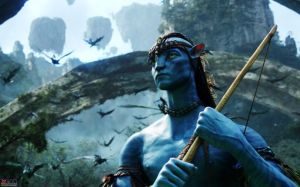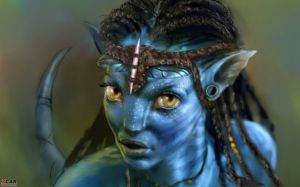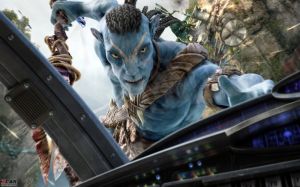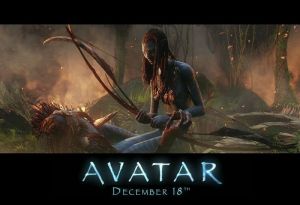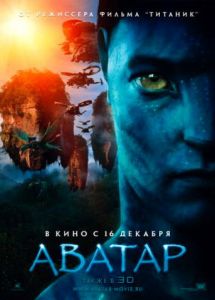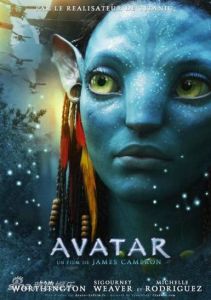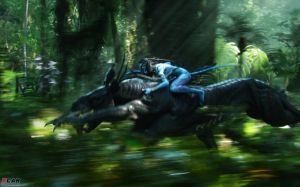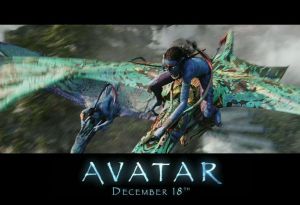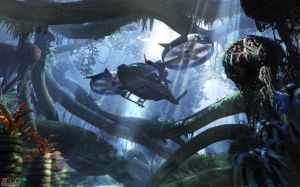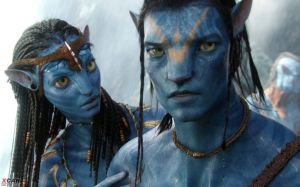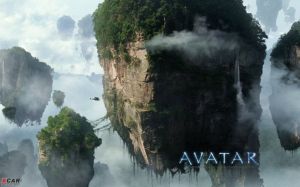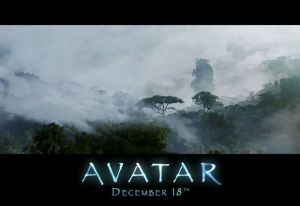Avatar
The word "Avatar" is a Sanskrit word, meaning literally "coming down from far away." Ava (as prefix to verbs and verbal nouns) expresses the idea of "off, away, down." The root AV seems at all times to denote the idea of protection from above, and is used in compounds, in words referring to protections by kings or rulers; in regard to the gods, it means accepted favourably when a sacrifice is offered. With the result that the root word can be said to mean "Coming down with the approval of the higher source from which it came and with benefit to the place at which it arrives."
In this film, it means that the human technology in the future is capable of injecting a human's intelligence into a remotely located body, a biological body.
Avatar is a American sicience fiction film by James Cameron. The film was released in traditional 2-D, as well as in 3-D, using the RealD 3D, Dolby 3D, and IMAX 3D formats. Avatar is officially budgeted at $237 million. Other estimates put the cost at $280–310 million to produce and $150 million for marketing.
Name: Avatar
Directed by: James Cameron
Produced by: James Cameron Jon Landau
Music by: James Horner
Cinematography: Mauro Fiore
Studio: Lightstorm Entertainment Dune Entertainment Ingenious Film Partners
Distributed by: 20th Century Fox
Release dates: December 10, 2009(London premiere)
December 18, 2009(United States)
January 2, 2010(China)
Running time: 162 minutes
Country: United States
Language: English
Genre: action thriller science fiction
In 2154, the RDA corporation is mining in Pandora, a planet in the Alpha Centauri star system. The corporation intends to exploit Pandora's reserves of a valuable mineral called unobtanium. A species called Na'vi, a ten-foot-tall blue-skinned species with tails, inhabit in Pandora. They live in harmony with nature and dislike human's behaviour of mining in their habitat.
Pandora's atmosphere is toxic to humans, so scientists grow Na'vi bodies modified with human DNA, called avatars, controlled by genetically matched, mentally linked human operators to mine unobtanium for human. Jake Sully, a paraplegic former Marine, replaces his twin brother who was murdered to control the avatar.
However, Jake is attacked by a predator and lost in Pandora. Neytiri, a female Na'vi, saves him and brings him to her Hometree. Over three months, Jake grows close to Neytiri and her clan called Omaticaya, eventually rejects RDA's agenda.
In order to mine unobtanium beneath the Hometree , human decides destroy it. Jake reveals his original mission to Neytiri and her clan, and Neytiri sees him as a betrayer. Then, the human's forces arrive and destroy the Hometree. And Jake is imprisoned by Quaritch, the leader of the forces, but he escapes.
Then, Jake comes back to the Omaticaya to regain their trust. With the assistance of Neytiri, Jake assembles over two thousand Na'vi from other clans to repel the humans. Finally, they defeat the human's forces. The remaining corporate personnel are expelled from Pandora.
Sam Worthington as Corporal Jake Sully, the film's protagonist, is a disabled former Marine who becomes part of the Avatar Program. Cameron cast the Australian actor after a worldwide search for promising young actors, preferring relative unknowns to keep the budget down. Cameron felt that he has that quality of being a guy you'd want to have a beer with, and he ultimately becomes a leader who transforms the world.
Sigourney Weaver as Dr. Grace Augustine, an exobiologist and head of the Avatar Program.
Michelle Rodriguez as Trudy Chacón, a Marine combat pilot assigned to support the Avatar Program.
Giovanni Ribisi as Parker Selfridge, the corporate administrator for the RDA mining operation and one of the film's primary antagonists.
Joel David Moore as Norm Spellman, an anthropologist who studies plant and nature life as part of the Avatar Program.
Stephen Lang as Colonel Miles Quaritch, the head of the mining operation's security detail.
Dileep Rao as Dr. Max Patel, a scientist who works in the Avatar Program.
Zoe Saldana as Neytiri, princess of the Omaticaya, the Na'vi clan, who is attracted to Jake because of his bravery.
C. C. H. Pounder as Mo'at, the Omaticaya's spiritual leader, Neytiri's mother, and consort to clan leader Eytucan.
Laz Alonso as Tsu'tey, heir to the chieftainship of the tribe, and Neytiri's formerly betrothed, prior to the events of the film.
Wes Studi as Eytucan, the Omaticaya's clan leader, Neytiri's father and Mo'at's mate.
In 1994, director James Cameron wrote a 80-page scriptment for Avatar, reportedly in just two weeks. In August 1996, Cameron announced that after completing Titanic, he would film Avatar, which would make use of synthetic, or computer-generated, actors. The project would cost $100 million and involve at least six actors in leading roles. Visual effects house Digital Domain, with whom Cameron has a partnership, joined the project, which was supposed to begin production in the summer of 1997 for a 1999 release. However, Cameron felt that the technology had not caught up with the story and vision that he intended to tell. He decided to concentrate on making documentaries and refining the technology for the next few years.
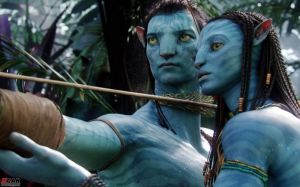
In July 2006, Cameron announced that he would film Avatar for a mid 2008 release and planned to begin principal photography with an established cast by February 2007. The following August, the visual effects studio Weta Digital signed on to help Cameron produce Avatar. Stan Winston, who had collaborated with Cameron in the past, joined Avatar to help with the film's designs.
In September 2006, Cameron was announced to be using his own Reality Camera System to film in 3-D. The system would use two high-definition cameras in a single camera body to create depth perception.
Meanwhile, while all this preparation was going on, Fox was wavering because of its painful experience with cost overruns and delays on Cameron's last picture, Titanic. Cameron installed a traffic light with the amber signal lit outside of co-producer Jon Landau's office to represent the film's uncertain future. He began shopping it around to other studios, and showed his proof-of-concept to Dick Cook, the chairman of The Walt Disney Company. However, In October 2006, Fox finally agreed to commit to making Avatar after Ingenious Media agreed to back the film, which reduced Fox's financial exposure to less than half of the film's official $237 million budget. After Fox greenlighted Avatar, Cameron and Landau switched the light to green.
Principal photography for Avatar began in April 2007, and was done around parts of Los Angeles as well as New Zealand. Cameron described the film as a hybrid with a full live-action shoot in combination with computer-generated characters and live environments. The live action was shot with a modified version of the proprietary digital 3-D Fusion Camera System, developed by Cameron and Vince Pace.
In January 2007, Fox had announced that 3-D filming for Avatar would be done at 24 frames per second despite Cameron's strong opinion that a 3-D film requires higher frame rate to make strobing less noticeable. According to Cameron, the film is composed of 60% computer-generated elements and 40% live action, as well as traditional miniatures. Motion-capture photography would last 31 days at the Hughes Aircraft stage in Playa Vista, Los Angeles, California. In October, Cameron was scheduled to shoot live-action in New Zealand for another 31 days. More than a thousand people worked on the production. In preparation of the filming sequences, all of the actors underwent professional training specific to their characters such as archery, horseback riding, firearms, and hand to hand combat. They also received language and dialect training in the Na'vi language created for the film.
Prior to shooting the film, Cameron also sent the cast to the jungle in Hawaii to get a feel for a rainforest setting before shooting on the soundstage. During filming, Cameron made use of his virtual camera system, a new way of directing motion-capture filmmaking. The system displays an augmented reality on a monitor, placing the actor's virtual counterparts into their digital surroundings in real time, allowing the director to adjust and direct scenes just as if shooting live action. Using conventional techniques, the complete virtual world cannot be seen until the motion-capture of the actors is complete. Cameron described the system as a "form of pure creation where if you want to move a tree or a mountain or the sky or change the time of day, you have complete control over the elements". Cameron gave fellow directors Steven Spielberg and Peter Jackson a chance to test the new technology. Spielberg and George Lucas were also able to visit the set to watch Cameron direct with the equipment.
The most exciting part is the outcome of the action scenes in the end. Cameron spent two years studying how to capture the ending, the 2.7 meter high Na'vi people use arrows to fight against humans in a jeep and a helicopter showdown. James said:" the last 20 minutes are so wrapped up with air, land, armored forces and infantry battle, and so it is absolutely ancestor of all wars, is the greatest thing I have ever done, this film also represents the achievements of my life."
From January to April 2006, Cameron worked on the script and developed a culture for the film's aliens, the Na'vi. Their language is created by Dr. Paul Frommer, a linguist. The Na'vi language has a vocabulary of about 1000 words, with some 30 added by Cameron. The tongue's phonemes include ejective consonants (such as the "kx" in "skxawng") that are found in the Amharic language of Ethiopia, and the initial "ng" that Cameron may have taken from New Zealand Māori. Actress Sigourney Weaver and the film's set designers met with Jodie S. Holt, a professor of plant physiology at UC Riverside, to learn about the methods used by botanists to study and sample plants, and to discuss ways to explain the communication between Pandora's organisms depicted in the film.
A number of revolutionary visual effects techniques were used in the production of Avatar. According to Cameron, work on the film had been delayed since the 1990s to allow the techniques to reach the necessary degree of advancement to adequately portray his vision of the film. The director planned to make use of photorealistic computer-generated characters, created using new motion-capture animation technologies he had been developing in the 14 months leading up to December 2006.
a motion-capture stage six times larger than any previously used, and an improved method of capturing facial expressions, enabling full performance capture are applied. According to Cameron, the method allows the filmmakers to transfer 100% of the actors' physical performances to their digital counterparts.
Besides the performance capture data which were transferred directly to the computers, numerous reference cameras gave the digital artists multiple angles of each performance. Moreover, digital effects were performed fully. Each minute of the final footage for Avatar occupied 17.28 gigabytes of storage.
For the love story between characters Jake and Neytiri, Cameron applied a star-crossed love theme. The couple comes from radically different cultures that are contemptuous of their relationship and is forced to choose sides between the competing communities. They both fall in love with each other, but they need to fight side-by-side, and so there's that kind of requirement to let the other person go in order to do what you need to do, which is kind of interesting.
Cameron wanted his film to make people have a conscience—"that maybe in the enjoying of it makes you think a little bit about the way you interact with nature and your fellow man". He added that "the Na'vi represent something that is our higher selves, or our aspirational selves, what we would like to think we are" and that even though there are good humans within the film, the humans "represent what we know to be the parts of ourselves that are trashing our world and maybe condemning ourselves to a grim future".
Cameron has acknowledged that Avatar implicitly criticizes America's War in Iraq and the impersonal nature of mechanized warfare in general. In reference to the use of the term "shock and awe" in the film, Cameron stated, "We know what it feels like to launch the missiles. We don't know what it feels like for them to land on our home soil, not in America." However, in a later interview, he said, "The film is definitely not anti-American." A scene in the film portrays the violent destruction of the towering Na'vi Hometree, which collapses in flames after a missile attack, coating the landscape with ash and floating embers. When asked about the scene's visual resemblance to the events of the September 11 attacks on the World Trade Center, Cameron said he had been surprised at how much it did look like September 11.
The film received generally positive reviews from film critics. Review aggregator Rotten Tomatoes reports that 82% of 248 professional critics have given the film a positive review, with a rating average of 7.4 out of 10.
"Watching Avatar, I felt sort of the same as when I saw Star Wars in 1977."
—Roger Ebert of the Chicago Sun-Times
"the script is a little bit obvious, but that is part of what made it work."
—A. O. Scott of At The Movies
"It extends the possibilities of what movies can do. Cameron's talent may just be as big as his dreams."
—Rolling Stone film critic Peter Travers
"Embrace the movie—surely the most vivid and convincing creation of a fantasy world ever seen in the history of moving pictures."
—Richard Corliss of Time magazine
"Avatar is a great epic, a imaginative film which brings us a new life experience."
"Avatar is a combination of great special effects and perfect plot."
"Avatar gives me a lesson—our human beings should examine our own conscience and protect our nature."
—All from filmgoers
Top 10 Films
Broadcast Film Critics
Best Action Movie
Best Art Direction
Best Cinematography
Best Editing
Best Sound
Best Visual Effects
Dallas-Fort Worth Film Critics Association
Top 10 Films
Florida Film Critics Circle
Best Cinematography
Golden Globe Awards
Best Director
Best Film – Drama
Las Vegas Film Critics Society
Sierra Award (Best Art Direction)
Phoenix Film Critics Society
Best Cinematography
Best Film Editing
Best Production Design
Best Visual Effects
Santa Barbara International Film Festival
Lucky Brand™ Modern Master Award
St. Louis Film Critics
Best Visual/Special Effects
Most Original/Innovative or Creative Film
Visual Effects Society Awards
Lifetime Achievement, for Making of
附件列表
词条内容仅供参考,如果您需要解决具体问题
(尤其在法律、医学等领域),建议您咨询相关领域专业人士。
如果您认为本词条还有待完善,请 编辑
上一篇 翻译练习(一) 下一篇 王振光——英语是在实际过程中“用”出来的

